Did you know that you can stay overnight in a caboose in Smiths Falls, Ontario?
I’ve known for a while and I’ve been eager to try it, but I didn’t get organized until this year, when I took up Becky Allen’s kind invitation.
Becky is the executive director of the Railway Museum of Eastern Ontario (RMEO) in Smiths Falls, which I’d visited before. It’s a great little museum that features a collection of vintage rolling stock outside and informative, fun displays about railway history inside a former CN railway station. Canadian Northern Ontario Railway built the station in 1912 and it’s now a National Historic Site.

On my previous visit, I’d peeped into the three (then-unoccupied) vintage cabooses that have been converted into unique Airbnb rentals, and I’d thought it would be a hoot to stay in one. When Becky’s email landed in my in-box, it just so happened that my sisters and I were starting to throw around ideas for one of our regular getaways. The three of us live widely scattered across Eastern and Southern Ontario, so we try to get together a few times a year.
When we learned that the largest RMEO caboose sleeps three, that sealed the deal. We made a plan to sleep in a caboose in Smiths Falls in mid-August.
Disclosure: We stayed in the caboose at no cost, as guests of the RMEO, which neither reviewed nor approved this post. All opinions are my own.
Checking into our RMEO caboose
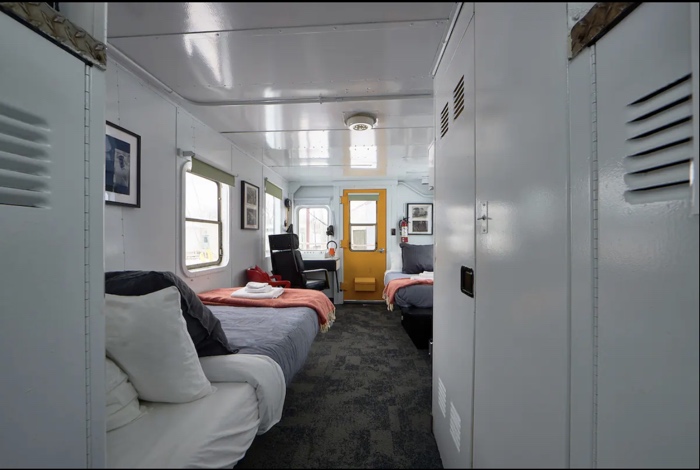
The RMEO is careful to state in its Airbnb listings that its vintage cabooses are not hotel rooms. The museum describes the overnight experience as glamping (AKA “glamour camping”). Each caboose is equipped with a portable air conditioner, and you can request a space heater, as well. The RMEO provides towels and bedding, and there are lots of extra blankets. The cabooses have electrical outlets and lighting, but no running water or kitchen facilities. For those mod cons, we would need to leave the caboose, walk down a short set of metal stairs, cross the wooden station platform and slip into the station.

When I arrived at the RMEO shortly after 4pm on a Sunday, my sisters Jane and Carol had already had a tour of the facilities in the museum building that are open for overnight guests: the staff kitchen, complete with fridge, freezer and microwave; a small common room with Lego and other toys for pint-sized guests; and spotless washrooms, each with an equally clean modern shower cubicle, stocked with shampoo, conditioner and shower gel.
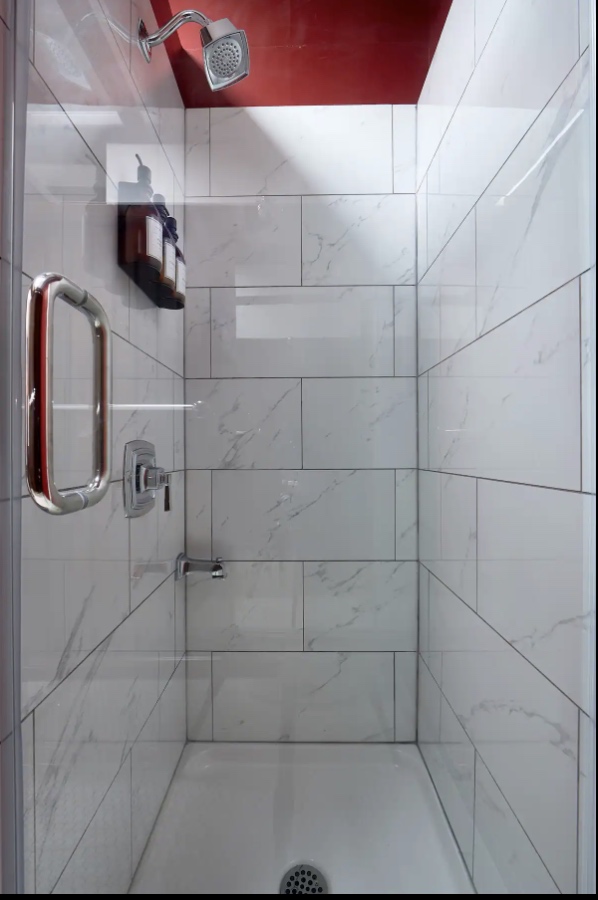
My sisters briefed me on the setup, then we settled into our home for the next three nights. (Later, Becky informed us that most guests book the caboose for one night only. We were as much of a curiosity to the museum staff as the accommodations were to us!)
What was the 1967 caboose like?
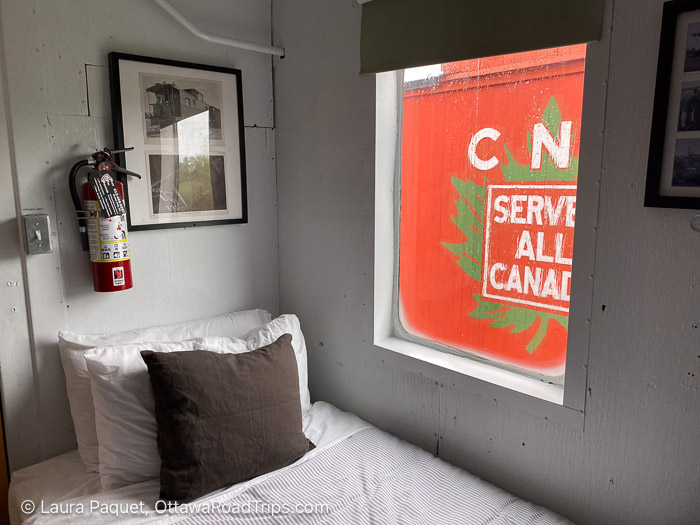
As I mentioned, we booked the 1967 Canadian National steel caboose because it was the largest one, with three single beds. The RMEO also offers a 1921 wooden caboose and a 1945 plywood caboose, each of which sleeps two.
Our steel caboose was long and narrow but surprisingly spacious. I suspect few guests come here planning to work, but if you do, there was a desk at each end of the caboose. There was also a small table with three chairs, where we congregated at night to snack and share stories. (There might have also been wine.)
The small sink was not hooked up, a fact we had to keep reminding ourselves of. The windows all had blinds but they still let in some light, so bring an eye mask if sunshine wakes you up. A small storage locker had enough hooks for our coats, and open metal shelves next to the locker were good places to stash purses, phones and the like.
The single beds were quite comfortable, with all the pillows, sheets and blankets we needed. In fact, the temperature dropped suddenly during our stay, so we ran the air conditioner on the first night and bundled under blankets the next. The air conditioner was somewhat noisy, so ear plugs might be another good item to bring along.
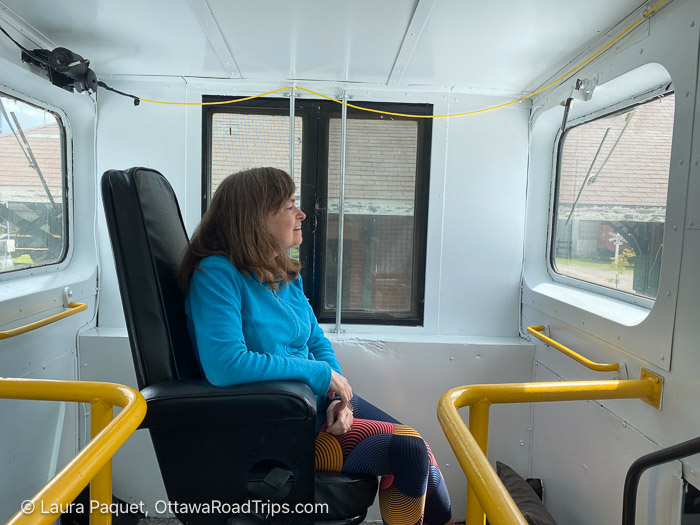
One of the most fun aspects of the caboose was the cupola—the small windowed section that sticks out of the roof of the caboose. Up there were two captain’s-style chairs, one on each side of the caboose, which we reached by climbing metal ladders attached to the walls. The chairs offered a great view and would have been nice places to curl up with a book on a rainy day…but we were too busy exploring the museum, Smiths Falls, and nearby Perth and Merrickville to spend much time in them.
Ottawa Road Trips vs. raccoon, again
In the middle of the night, when I woke up in need of the loo, the “camping” part of our glamping experience came into play. I put on my sandals and tiptoed to the caboose door, making sure to pick up the key from the desk along the way. (I really, really didn’t want to get trapped on the station platform at 2:30am in my pyjamas.)
Hanging onto the rails on each side of the metal steps, I made for the platform. Then I stopped dead, as the platform was already…occupied. A ginormous raccoon stood placidly observing me from about 10 metres away. Coming to my senses, I skittered across the platform, opened the door to the staff kitchen and washrooms, and dashed into the station.
A few minutes later, he (she?) was still going about whatever business raccoons go about on a station platform in the middle of the night, when I crept back into the caboose.
Side note: What is it about me, middle-of-the-night raccoons and glamping in the Smiths Falls area? I’d previously had a close encounter with what sounded like a herd (troop? gang?) of raccoons while staying in a Parks Canada oTENTik at the Upper Beveridges lockstation on the Rideau Canal. It was not my finest or bravest hour.
What to see at the Railway Museum of Eastern Ontario
Of course, staying in one of the RMEO cabooses gives you lots of time to explore the museum at your leisure. The RMEO consists of the refurbished 1912 station and a collection of “rolling stock”—railway lingo for assorted locomotives and train cars. The little station charmed my sisters and me immediately, as we’d grown up about three blocks from a similar station in our hometown of Brampton, Ontario.
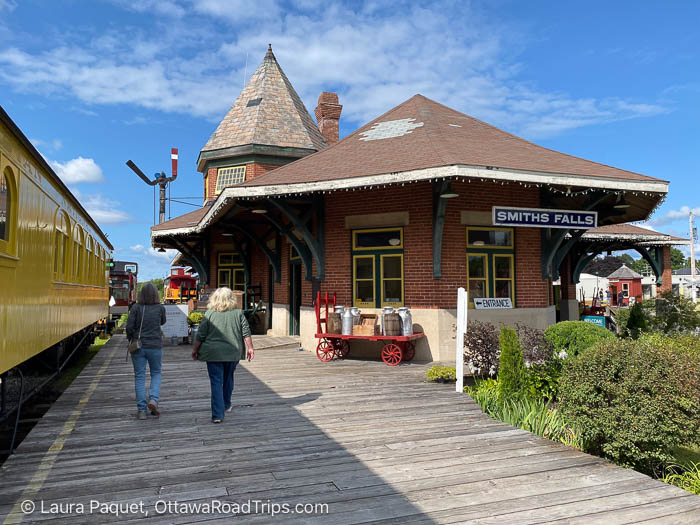
When we were little, one of our favourite after-dinner outings was to walk to the station with our dad, sit on one of the antique wooden luggage carts and wait for a freight train to go by. We’d count the cars, ask Dad where boxcars marked “B&O” or “Chessy System” might have come from, and anticipate the arrival of the caboose so we could wave excitedly to the conductor—or, as we called him, the “corner doctor.” To our delight, we saw that the RMEO has several luggage carts similar to the ones we remembered.
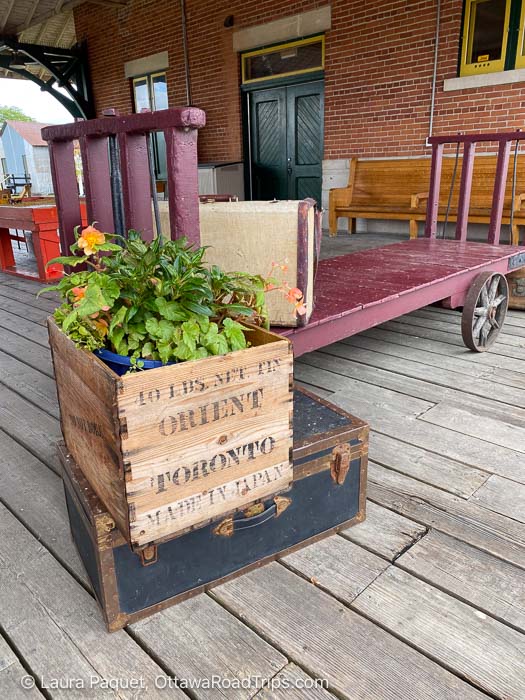
Inside the old station, you’ll find a wonderful collection of railway artifacts and memorabilia, including benches that once graced Ottawa’s Union Station (now the temporary home of the Senate of Canada). You’ll find lanterns and maps, schedules and a telegraph machine, and so much more. If you’re not sure what anything is, just ask, as the museum staff have a wealth of information to share. For instance, in the photo below, staffer Nate Flinn demonstrates a gadget that station masters used to pass paper messages to conductors on passing trains (with my sister Carol playing the part of the conductor).

Nate was also our pilot for a short trip on the museum’s handcar. Fans of old Looney Tunes cartoons will be familiar with these little cars with a two-sided handle that railway workers could pump up and down to travel the rails without fuel. (Fun fact: When they reached their destination, the workers were often required to lift the heavy little car off the rails to clear the track for other trains, then heft it back onto the track when it was time to go home.) It was fun pumping our way a few hundred metres down a siding and back again.
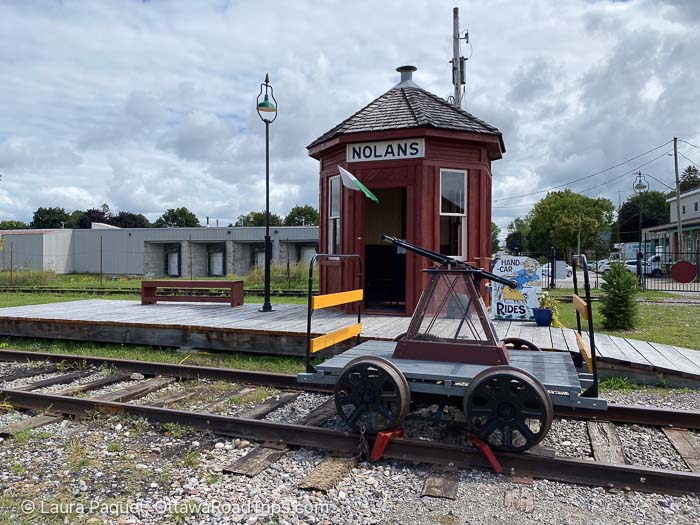
Not far from the handcar platform was a grand 1947 Cadillac Series 75 limousine, mounted on rails. One of the quirkiest items in the museum’s collection, it was converted from a road car to a rail car for Canadian Pacific Railway (CPR) president Norris “Buck” Crump. Crump used it to scoot along the rails from the CPR’s headquarters in Montreal to nearby spots such as Ottawa.
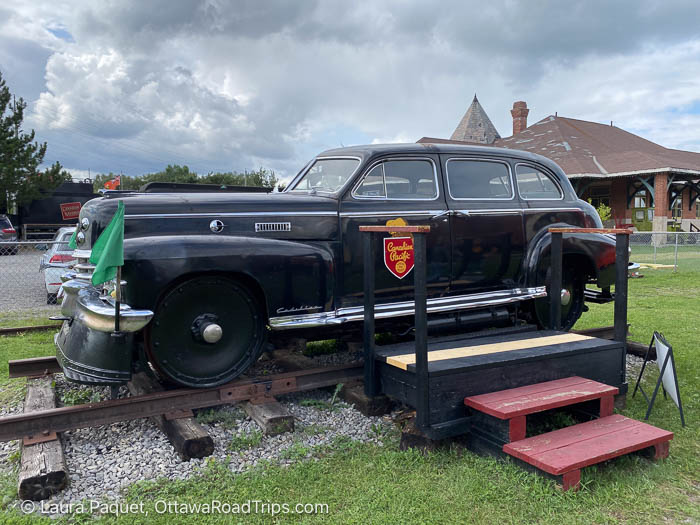
We poked our heads into several other railcars, including a boxcar. One of my favourites was the dental car, which was originally built in 1913 as a sleeping car. In the 1950s, it was retrofitted as a rolling dental office, and dentists used it for seven years to provide services in remote areas of northern Ontario.
One of the most glamorous cars, though, was the dining car—and that’s where we enjoyed the most elegant meal of our trip.
Afternoon tea in the RMEO dining car
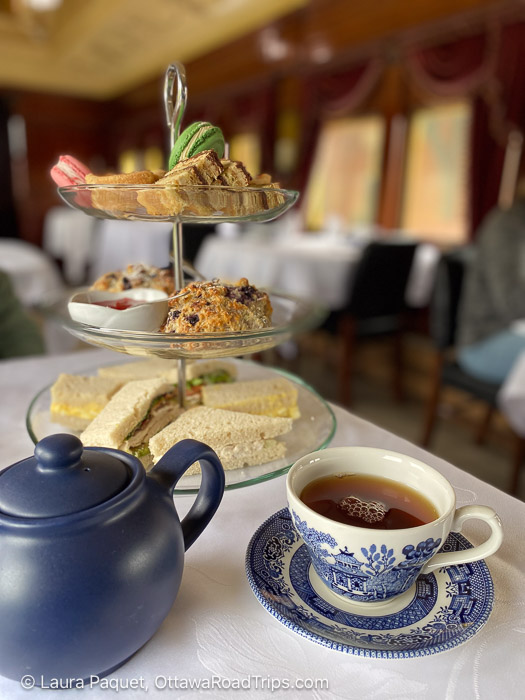
Built in 1899, the museum’s dining car has been lovingly restored to its richly panelled, late-Victorian grandeur. It’s been upgraded with modern conveniences, including air conditioning and electric lights, but it’s still easy to imagine fine ladies in long gowns and gentlemen in bow ties enjoying their meals while admiring the scenery through the large windows.
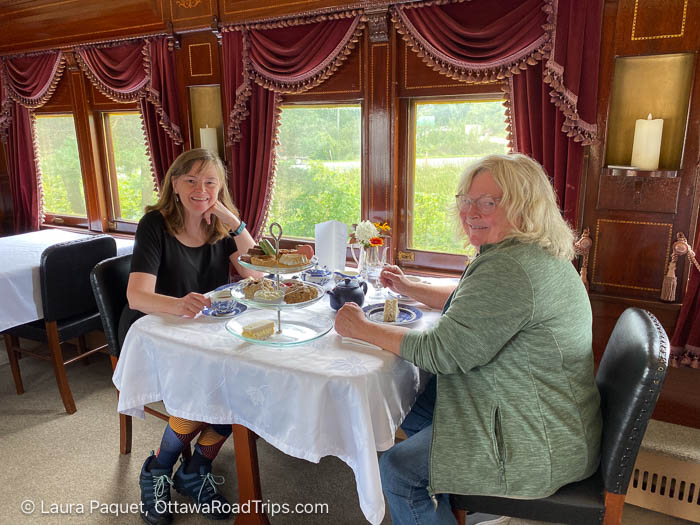
The RMEO holds afternoon teas multiple times from late spring through early fall, and tickets usually sell out quickly. We were delighted that they put on an afternoon tea just for us. Along with a selection of black and herbal teas, we worked our way through three-tiered plates filled with finger sandwiches, scones with whipped cream and strawberry jam, and more desserts than we could possibly finish. Often, the afternoon tea goodies are prepared by museum volunteers, but in this case, they came from local C’Est Tout Bakery and Bistro.
Nate and Becky regaled us with stories of railway dining in years gone by as they kept a steady stream of food and drink coming our way. It was a delicious—and filling—way to spend an hour.
Speaking of food…
I won’t get into a huge amount of detail about the restaurants we visited, as this post is already getting a bit long! However, I’d like to give a shoutout to a few that really stood out.
The Vault Eatery and Pub (2 Russell Street East, Smiths Falls) serves a small but varied menu that ranges from pasta and salmon to a quinoa bowl. I really enjoyed my pad Thai, but more than that, I appreciated the restaurant’s ambiance—just loud enough to feel lively, but quiet enough that we could easily carry on a conversation.

As well as making tasty afternoon tea fare, C’Est Tout Bakery and Bistro (20 Beckwith Street North, Smiths Falls) has a well-deserved reputation as a good breakfast spot. Brunch is served daily from 8am to 2pm, and I can highly recommend the Rideau breakfast sandwich (bacon, egg and cheddar on a cheddar scone, with a light green salad).
About a 15-minute drive west of the museum in Perth, Gather (40 Gore Street East, Perth) bills itself as serving “modern wholesome comfort food.” And that nicely sums up the special of the day all three of us chose for lunch, a beef sandwich liberally drizzled with freshly made chimichurri.
Other fun in and around Smiths Falls
Our RMEO caboose was a great base of operations. We spent a laid-back day tooling around Smiths Falls, exploring the museum and watching boats cruising along the Rideau Canal. One day, we drove 15 minutes west to Perth and enjoyed browsing for items by local artisans at Riverguild Fine Crafts (51 Gore Street East, Perth) and everything from turquoise jewellery to tarot cards at Dragon Moon (2 Gore Street East, Perth). Another day, we drove 15 minutes east from Smiths Falls to Merrickville, where we spent some serious time browsing through the cookware, food and so much more at Mrs. McGarrigle’s (311 St. Lawrence Street, Merrickville).
We tend to drift toward window shopping when we’re together, but others might prefer hiking or cycling the Cataraqui Trail (a rail-to-trail route that starts in Smiths Falls), checking out the Perth Museum, or paddling on the Rideau Canal.
If you go
Cabooses are available for overnight stays from early May until mid-October. For the latest information on prices and availability, see the RMEO website.
Looking for more tips on things to see and do in and around Ottawa? Subscribe to my free weekly newsletter or order a copy of my book, Ottawa Road Trips: Your 100-km Getaway Guide.
As the owner of Ottawa Road Trips, I acknowledge that I live on, work in and travel through the unceded, unsurrendered territory of the Algonquin Anishinaabeg Nation. I am grateful to have the opportunity to be present on this land. Ottawa Road Trips supports Water First, a non-profit organization that helps address water challenges in Indigenous communities in Canada through education, training and meaningful collaboration.

4 comments
[…] Posts Heads Up: Montreal deals, Gatineau covered bridges, hike… Sleep in a caboose in Smiths Falls! Heads Up: Music fest discounts and Fibrefest workshops Heads Up: Kingston WritersFest, […]
[…] P.S.: Here’s what it’s like to stay overnight in an RMEO caboose. […]
[…] After a spirited debate, the Smiths Falls town council recently approved $50,000 in funding for the Railway Museum of Eastern Ontario. The money has to be re-approved each year and can be used only for capital expenditures. (P.S.: Did you know you can stay overnight in the museum’s three vintage cabooses?) […]
[…] Want to treat Dad to a ride on a vintage train (in a caboose!) and a visit to a classic car show on Father’s Day, which falls on Sunday, June 15? Tickets are on sale now for this Father’s Day fun at the Railway Museum of Eastern Ontario in Smiths Falls. (P.S.: If you want to learn more about the cabooses, check out my post about staying in one overnight.) […]